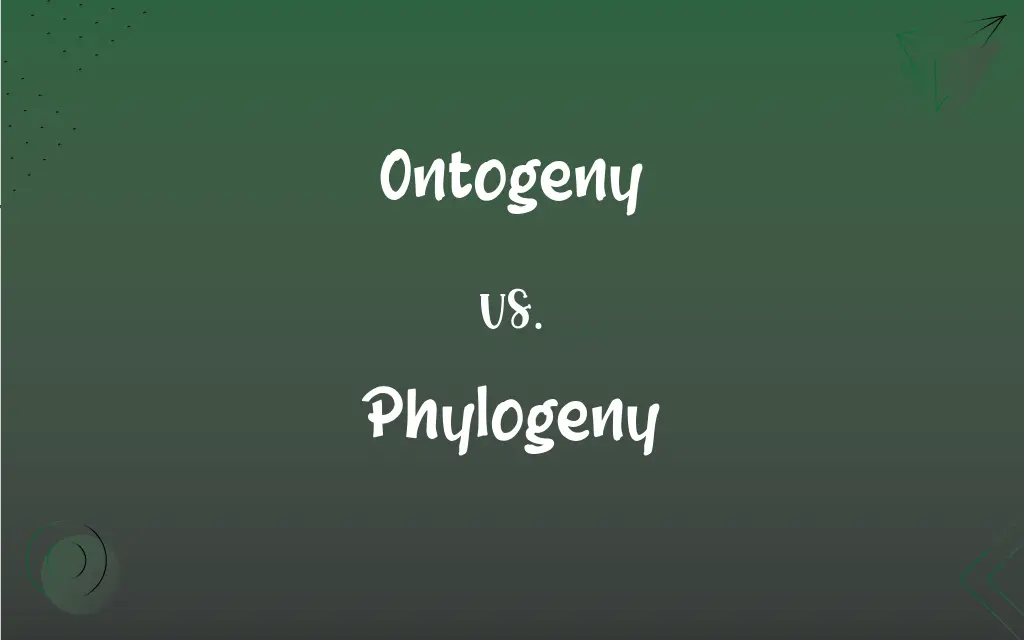Ontogeny vs. Phylogeny: What's the Difference?
Edited by Aimie Carlson || By Janet White || Published on February 18, 2024
Ontogeny is the development of an individual organism from embryo to maturity. Phylogeny is the evolutionary history and lineage of a species or group of species.

Key Differences
Ontogeny refers to the developmental process of an individual organism from embryonic stage to its mature form. Phylogeny deals with the evolutionary development and diversification of a species or group of organisms.
Ontogeny focuses on the life cycle and growth of a single organism, while phylogeny traces the genetic, structural, and evolutionary relationships among different species over time.
Ontogeny encompasses physical, cellular, and molecular changes in an organism as it grows. Phylogeny explores the branching patterns of evolution, showing how species are related through common ancestry.
The study of ontogeny can provide insights into the development of species-specific traits. In contrast, phylogeny helps in understanding the broader picture of evolutionary history and relationships among various species.
Ontogeny may reflect certain aspects of a species' evolutionary history (a concept known as recapitulation), but it is distinct from the broader scope of phylogeny which encompasses the entire evolutionary lineage.
ADVERTISEMENT
Comparison Chart
Focus
Development of an individual organism
Evolutionary history of a species
Scope
Individual life cycle
Evolutionary relationships and lineage
Study Area
Growth, development, maturation
Evolution, species relationships
Key Elements
Cellular, physical changes
Genetic, structural evolutionary changes
End Goal
Understanding individual development
Understanding species evolution
ADVERTISEMENT
Ontogeny and Phylogeny Definitions
Ontogeny
The sequence of events involved in the development of an organism.
The ontogeny of a frog from tadpole to adult is a classic biology lesson.
Phylogeny
Traces the ancestral lines and relationships between species.
The phylogeny of flowering plants reveals a complex evolutionary history.
Ontogeny
Encompasses the physiological, anatomical, and molecular changes during an organism's life.
Research on the ontogeny of birds reveals how they acquire flight skills.
Phylogeny
The evolutionary history and lineage of species or groups of organisms.
The phylogeny of mammals shows their divergence from reptilian ancestors.
Ontogeny
The growth and development process of an individual organism.
Studying the ontogeny of butterflies offers insight into metamorphosis.
Phylogeny
The branching pattern of evolution across species.
Insects have a diverse phylogeny, indicating their adaptability.
Ontogeny
The progression from a single cell to a fully formed organism.
Human ontogeny begins with a fertilized egg and ends at adulthood.
Phylogeny
The study of how different groups of organisms are genetically and evolutionarily related.
Phylogeny helps in understanding the evolutionary relationships among bird species.
Ontogeny
The individual development trajectory of an organism.
Ontogeny studies in plants can explain how they adapt to different environments.
Phylogeny
The study of the evolutionary development of a species.
Understanding the phylogeny of pathogens is crucial for developing treatments.
Ontogeny
The development of an individual organism or a part of an organism from inception to maturity. Also called ontogenesis.
Phylogeny
The evolutionary development and history of a species or trait of a species or of a higher taxonomic grouping of organisms
The phylogeny of Calvin cycle enzymes. Also called phylogenesis.
Ontogeny
Ontogenesis
Ontogeny
(biology) the process of an individual organism growing organically; a purely biological unfolding of events involved in an organism changing gradually from a simple to a more complex level;
He proposed an indicator of osseous development in children
FAQs
What does phylogeny refer to?
The evolutionary history and lineage of species.
What tools are used to study phylogeny?
Genetic sequencing, fossil records, and morphological analysis.
Can ontogeny affect phylogeny?
Ontogenetic processes can reflect evolutionary history but are distinct from phylogeny.
What is ontogeny?
It's the development of an organism from embryo to maturity.
How is ontogeny different from phylogeny?
Ontogeny is about individual development, while phylogeny is about species evolution.
What is the significance of studying ontogeny?
It helps understand developmental processes and stages of an organism.
Why is phylogeny important in biology?
It reveals how species are related and have evolved over time.
Is human development an example of ontogeny?
Yes, human development from conception to adulthood is ontogeny.
Is ontogeny limited to physical development?
No, it includes molecular, cellular, and psychological development.
Does ontogeny encompass behavioral development?
Yes, it includes all aspects of an organism's growth and development.
Does ontogeny include the aging process?
Yes, it encompasses the entire lifespan, including aging.
Are ontogeny and phylogeny interconnected?
They are related concepts but focus on different scales of development.
How does phylogeny help in conservation biology?
It aids in understanding species' evolutionary history, crucial for conservation strategies.
What is a common misconception about phylogeny?
That it always implies linear progression; in reality, evolution is often branching and complex.
How does phylogeny inform taxonomy?
It helps classify organisms based on evolutionary relationships.
Can ontogeny provide insights into an organism's evolution?
Yes, developmental processes can offer clues about evolutionary history.
How do scientists reconstruct phylogeny?
By analyzing genetic, morphological, and fossil data.
Can ontogeny vary significantly within a species?
Yes, individual developmental pathways can vary due to genetics and environment.
What is a phylogenetic tree?
A diagram showing the evolutionary relationships among various species.
What role does DNA analysis play in phylogeny?
DNA analysis is crucial for understanding genetic relationships and evolutionary patterns.
About Author
Written by
Janet WhiteJanet White has been an esteemed writer and blogger for Difference Wiki. Holding a Master's degree in Science and Medical Journalism from the prestigious Boston University, she has consistently demonstrated her expertise and passion for her field. When she's not immersed in her work, Janet relishes her time exercising, delving into a good book, and cherishing moments with friends and family.
Edited by
Aimie CarlsonAimie Carlson, holding a master's degree in English literature, is a fervent English language enthusiast. She lends her writing talents to Difference Wiki, a prominent website that specializes in comparisons, offering readers insightful analyses that both captivate and inform.







































































